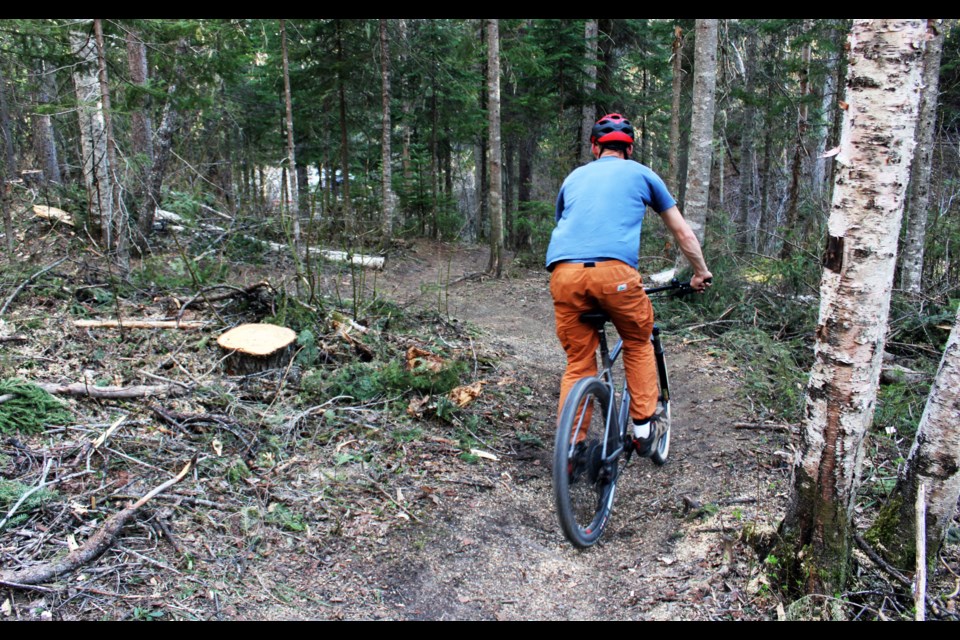Geoff Salton knew the Pidherny recreation site, home of his go-to mountain bike trails, was being selectively logged by the province over the winter to reduce the forest fire hazard.
What he did not expect when he went for a ride a couple weeks ago was to see some of his favourite trails obliterated by heavy equipment.
He saw sections of trails that feed into the lower parking lot – Ditch Pig, Shady Lane – that have been wiped out by heavy equipment crossings and one trail – Get Cooked (Entropy) – that’s been obliterated by excavators to access areas of the dense forest in the steeply-banked area.
“The logging contractor was to mark out the trails to cause minimal damage to the trails themselves. This did not happen and the damage to the trails is extensive,” said Salton. “My concern is the ministry is saying they will make everything right, but they haven’t expanded on that. It’s going to take a long time to rebuild the trails that they’ve already destroyed. They just basically went in there and thinned the trees and made no attempt to try to preserve the trails and they’ve ruined the lower part of it.”
Starting in December and continuing through February, the Pidherny Wildfire Risk Reduction Project focused on the lower trails at the popular recreation site, located on a large slope that borders a residential area on the north side of North Nechako Road. The idea was to remove as much combustible brush and dead snags as possible and thin trees clumped close to each other to prevent crowning fires.
“People in city council need to understand what’s going on, this is a huge tourist attraction for people and a place for kids and families to get out and ride together or hike and jog and it’s really disappointing to see what they’ve done out there,” said Salton. “I think we need to try to stop the next round of logging until there’s some better ground rules laid out for these guys.”
Part of Pidherny is on Crown land within the Fraser-Fort George regional district in an area the Prince George Cycling Club (PGCC) manages and part of it is Crown land within the city boundary over which the club has no licence of occupation management agreement. Trails have been built by volunteers in both areas.
PGCC Pidherny director Bret Hutchinson said the wildfire project has disrupted between 15 and 20 trails that enter into both jurisdictions and he says club members are worried the forest ministry won’t live up to its promise to fix them.
He spoke with ministry staff during a site visit in January and recommended that the province hire a professional trail builder to assess the damage and oversee the work of a contractor to do the repairs under the authority of that trail builder. He says he has no written confirmation that will be done.
“They said they are going to do the right thing and we’re at that point where it’s time to do the right thing and I haven’t seen it yet,” said Hutchinson. “All they will talk about is the trails in the rec site, but obviously there are a lot of great tails outside of the rec site and people are upset about those ones, too, and so am I. Volunteers built these trails and it’s going to be unacceptable if they leave these repairs to volunteers.”
The province says it will make those trail repairs in the second phase of the Pidherny project, slated to begin sometime this summer.
Hayley DeBianchi, Ministry of Forests land and resource coordinator for wildlire risk reduction for the Prince George region, walked the treatment area with Hutchinson last fall to identify all the trails that would be affected.
“Any identified trail within the treatment boundary is eligible for cleanup and repair,” said DeBianchi. “Prior to machines entering Pidherny, extensive effort was made to identify trails within the treatment unit. The province collaborated with Bret Hutchinson to ensure all the trails were on the map before work began. The goal was to minimize the amount of disturbance to the trails that were mapped, and repair any damage once treatment was complete.”



